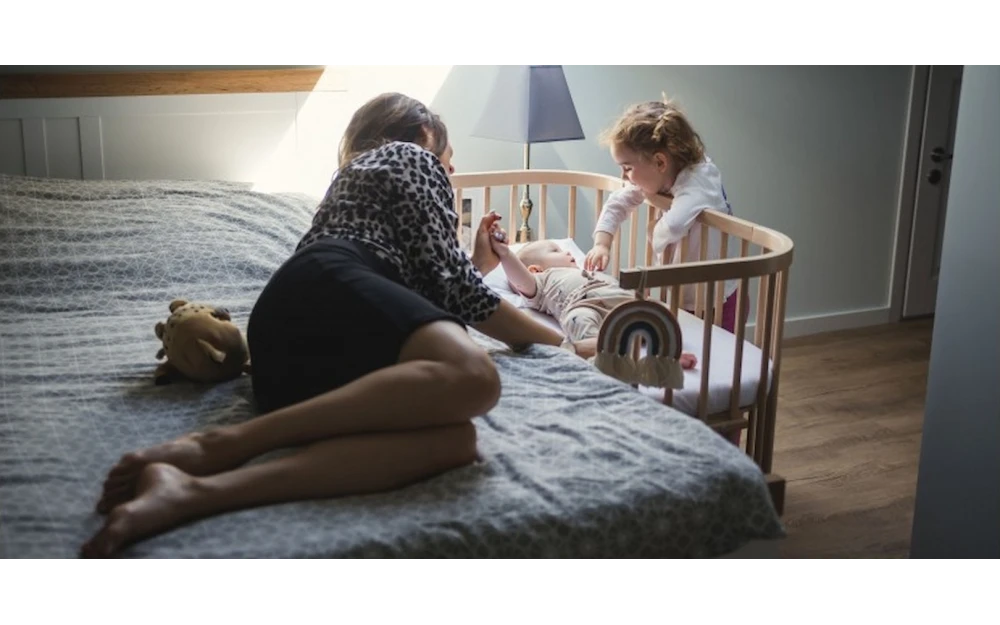Which Co-Sleeping Crib Should You Choose?

Choosing your baby’s first sleeping space is an important — and often emotional — decision. You want to keep your little one close and safe, while also ensuring your own comfort during those first precious but demanding months.
A co-sleeping crib offers the perfect balance between closeness, safety, and convenience. This guide will help you understand what to look for when choosing the ideal model for your family.
What Is a Co-Sleeping Crib and What Is It Used For?
A co-sleeping crib (or bedside crib) is a baby bed with one removable side that can be securely attached to the parents’ bed. Its main purpose is to create a shared sleeping environment while still giving the baby a separate and safe space. Among its main advantages are easier nighttime breastfeeding and constant supervision of your baby.
The Main Benefits of a Co-Sleeping Crib
Research by Professor James J. McKenna, an anthropologist at the University of Notre Dame, has shown that when a mother and baby sleep close together, they synchronize their breathing and sleep cycles. The mother’s calm breathing stimulates the baby’s respiratory system, helping the infant maintain a regular rhythm and reducing the risk of apnea.
In addition, the mother’s body heat acts as a natural temperature regulator, helping the baby keep a stable body temperature and steady heartbeat. Professor McKenna also found that mothers who sleep close to their infants breastfeed two to three times more often during the night. These short, frequent feedings perfectly match the baby’s needs and naturally support milk production. This phenomenon, known as “breastsleeping,” highlights the deep connection between sleep and breastfeeding.
Similar findings were confirmed by Professor Helen Ball from the Durham Infancy & Sleep Centre (ISIS) in the United Kingdom. With a co-sleeping crib, you can respond to your baby’s needs almost instantly — without fully waking up — allowing both of you to fall back asleep more easily.
Safety Criteria for a Co-Sleeping Crib
A safe co-sleeping crib should meet four essential requirements:
1. Stable Attachment System – It must include a secure mechanism (such as safety belts or special hooks) to attach the crib firmly to the parents’ bed and prevent any gaps.
2. Adjustable Height – The base should be adjustable so the baby’s mattress aligns perfectly with the parents’ mattress.
3. Durable Construction – The crib should be made of solid beech wood and finished with non-toxic, water-based paints. Wheels should include a locking system for added stability.
4. Compliance with Safety Standards – The design should meet general safety standards for baby furniture, such as the PN-EN 716 certification.
.jpg)
What’s the Difference Between the Waldin 7in1 and 2in1 Co-Sleeping Cribs?
The main difference lies in how long and how broadly each model can be used. A modular crib, such as the Waldin 7in1, is a multi-stage piece of furniture that serves as a co-sleeping crib in the early months and later transforms into other items. The Waldin 2in1 co-sleeping crib, on the other hand, is specifically designed for extended co-sleeping (up to around 1.5 years) and offers fewer transformation options.
| Feature | Waldin 7in1 Crib | Waldin 2in1 Co-Sleeping Crib |
| Main Function | Multi-stage furniture (0–10 years) | Co-sleeping crib with mini-crib option (0–1.5 years) |
| Co-Sleeping Bed Dimensions | 77.5 cm x 37.5 cm | 90 cm x 50 cm |
| Material | Solid beech wood | Solid beech wood |
| Additional Functions | Cradle, oval crib, playpen, open playpen, table, 2 chairs | Mini crib on wheels |
| Attachment System | Safety belt | Metal hook attached to bed frame |
| Mattress Included | Yes, three-part mattress for different configurations | Yes, one-piece mattress, 6 cm thick, firmness T25 |
| Ideal For | Parents looking for a versatile long-term solution | Parents planning extended co-sleeping and night feeding |
Which Model Should You Choose?
Your choice between the Waldin 7in1 and Waldin 2in1 depends on your family’s preferences and how long you plan to use the crib in co-sleeping mode. The 7in1 model offers long-term value and multifunctionality, adapting as your child grows. The 2in1 version, however, provides a larger sleeping surface and greater comfort for both mother and baby during the co-sleeping phase.
